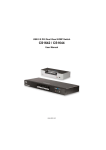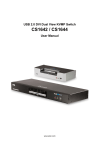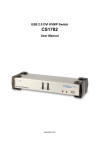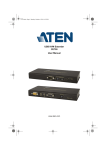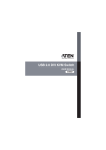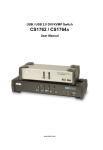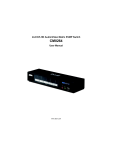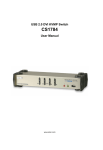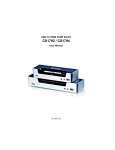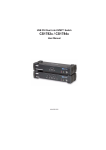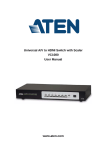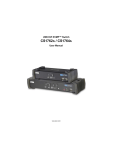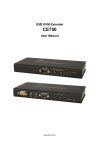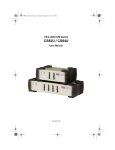Download USB DVI Dual View KVMP Switch CS1642A / CS1644A User Manual
Transcript
USB DVI Dual View KVMP Switch CS1642A / CS1644A User Manual VM5808H User Manual EMC Information FEDERAL COMMUNICATIONS COMMISSION INTERFERENCE STATEMENT This equipment has been tested and found to comply with the limits for a Class A digital device, pursuant to Part 15 of the FCC Rules. These limits are designed to provide reasonable protection against harmful interference when the equipment is operated in a commercial environment. This equipment generates, uses, and can radiate radio frequency energy and, if not installed and used in accordance with the instruction manual, may cause harmful interference to radio communications. Operation of this equipment in a residential area is likely to cause harmful interference in which case the user will be required to correct the interference at his own expense. FCC Caution: Any changes or modifications not expressly approved by the party responsible for compliance could void the user's authority to operate this equipment. CE Warning: This is a class A product. In a domestic environment this product may cause radio interference in which case the user may be required to take adequate measures. RoHS This product is RoHS compliant. SJ/T 11364-2006 The following contains information that relates to China. ii VM5808H User Manual User Information Online Registration Be sure to register your product at our online support center: International http://support.aten.com North America http://www.aten-usa.com/product_registration Telephone Support For telephone support, call this number: International 886-2-8692-6959 China 86-10-5255-0110 Japan 81-3-5615-5811 Korea 82-2-467-6789 North America 1-888-999-ATEN ext 4988 United Kingdom 44-8-4481-58923 User Notice All information, documentation, and specifications contained in this manual are subject to change without prior notification by the manufacturer. The manufacturer makes no representations or warranties, either expressed or implied, with respect to the contents hereof and specifically disclaims any warranties as to merchantability or fitness for any particular purpose. Any of the manufacturer's software described in this manual is sold or licensed as is. Should the programs prove defective following their purchase, the buyer (and not the manufacturer, its distributor, or its dealer), assumes the entire cost of all necessary servicing, repair and any incidental or consequential damages resulting from any defect in the software. The manufacturer of this system is not responsible for any radio and/or TV interference caused by unauthorized modifications to this device. It is the responsibility of the user to correct such interference. The manufacturer is not responsible for any damage incurred in the operation of this system if the correct operational voltage setting was not selected prior to operation. PLEASE VERIFY THAT THE VOLTAGE SETTING IS CORRECT BEFORE USE. iii VM5808H User Manual Package Contents The CS1642A / CS1644A package consists of: 1 CS1642A / CS1644A USB DVI Dual View KVMP Switch 2 Custom USB DVI-D Dual Link Cables Sets (CS1642A) 2 Custom DVI-D Dual Link Cables (CS1642A) 4 Custom USB DVI-D Dual Link Cable Sets (CS1644A) 4 Custom DVI-D Dual Link Cables (CS1644A) 1 Power Adapter 1 User Instructions* Check to make sure that all the components are present and that nothing got damaged in shipping. If you encounter a problem, contact your dealer. Read this manual thoroughly and follow the installation and operation procedures carefully to prevent any damage to the unit, and/or any of the devices connected to it. * Features may have been added to the CS1642A / CS1644A since this manual was published. Please visit our website to download the most up-to-date version of the manual. © Copyright 2013 ATEN® International Co., Ltd. Manual Part No. PAPE-0303-AT4G Manual Date: 2014-01-15 ATEN and the ATEN logo are registered trademarks of ATEN International Co., Ltd. All rights reserved. All other brand names and trademarks are the registered property of their respective owners. iv VM5808H User Manual Contents FCC Information . . . . . . . . . . . . . . . . . . . . . . . . . . . . . . . . . . . . . . . . . . . . . ii RoHS. . . . . . . . . . . . . . . . . . . . . . . . . . . . . . . . . . . . . . . . . . . . . . . . . . . . . ii SJ/T 11364-2006 . . . . . . . . . . . . . . . . . . . . . . . . . . . . . . . . . . . . . . . . . . . . ii User Information . . . . . . . . . . . . . . . . . . . . . . . . . . . . . . . . . . . . . . . . . . . . .iii Online Registration . . . . . . . . . . . . . . . . . . . . . . . . . . . . . . . . . . . . . . . .iii Telephone Support . . . . . . . . . . . . . . . . . . . . . . . . . . . . . . . . . . . . . . . .iii User Notice . . . . . . . . . . . . . . . . . . . . . . . . . . . . . . . . . . . . . . . . . . . . . .iii Package Contents. . . . . . . . . . . . . . . . . . . . . . . . . . . . . . . . . . . . . . . . . . . iv About this Manual . . . . . . . . . . . . . . . . . . . . . . . . . . . . . . . . . . . . . . . . . . . vii Conventions . . . . . . . . . . . . . . . . . . . . . . . . . . . . . . . . . . . . . . . . . . . . . . .viii Product Information. . . . . . . . . . . . . . . . . . . . . . . . . . . . . . . . . . . . . . . . . .viii Chapter 1. Introduction Overview . . . . . . . . . . . . . . . . . . . . . . . . . . . . . . . . . . . . . . . . . . . . . . . . . . . 1 Features . . . . . . . . . . . . . . . . . . . . . . . . . . . . . . . . . . . . . . . . . . . . . . . . . . . 3 Requirements . . . . . . . . . . . . . . . . . . . . . . . . . . . . . . . . . . . . . . . . . . . . . . . 5 Console . . . . . . . . . . . . . . . . . . . . . . . . . . . . . . . . . . . . . . . . . . . . . . . . . 5 Computers . . . . . . . . . . . . . . . . . . . . . . . . . . . . . . . . . . . . . . . . . . . . . . . 5 Cables . . . . . . . . . . . . . . . . . . . . . . . . . . . . . . . . . . . . . . . . . . . . . . . . . . 5 CS1642A . . . . . . . . . . . . . . . . . . . . . . . . . . . . . . . . . . . . . . . . . . . . . 5 CS1644A . . . . . . . . . . . . . . . . . . . . . . . . . . . . . . . . . . . . . . . . . . . . . 5 Operating Systems . . . . . . . . . . . . . . . . . . . . . . . . . . . . . . . . . . . . . . . . 6 Components . . . . . . . . . . . . . . . . . . . . . . . . . . . . . . . . . . . . . . . . . . . . . . . . 7 CS1642A Front View . . . . . . . . . . . . . . . . . . . . . . . . . . . . . . . . . . . . . . . 7 CS1642A LED Status Panel Detail . . . . . . . . . . . . . . . . . . . . . . . . . 7 CS1644A Front View . . . . . . . . . . . . . . . . . . . . . . . . . . . . . . . . . . . . . . . 8 CS1644A LED Status Panel Detail . . . . . . . . . . . . . . . . . . . . . . . . . 8 CS1642A Rear View . . . . . . . . . . . . . . . . . . . . . . . . . . . . . . . . . . . . . . 10 CS1644A Rear View . . . . . . . . . . . . . . . . . . . . . . . . . . . . . . . . . . . . . . 10 Chapter 2. Hardware Setup Cable Connection . . . . . . . . . . . . . . . . . . . . . . . . . . . . . . . . . . . . . . . . . . . 13 Installation Diagram. . . . . . . . . . . . . . . . . . . . . . . . . . . . . . . . . . . . . . . 15 Quad-View (DCC Mode) . . . . . . . . . . . . . . . . . . . . . . . . . . . . . . . . . . . . . . 16 Quad-View Installation . . . . . . . . . . . . . . . . . . . . . . . . . . . . . . . . . . . . 17 Chapter 3. Basic Operation Manual Switching . . . . . . . . . . . . . . . . . . . . . . . . . . . . . . . . . . . . . . . . . . . 19 Hot Plugging . . . . . . . . . . . . . . . . . . . . . . . . . . . . . . . . . . . . . . . . . . . . . . . 20 Powering Off and Restarting . . . . . . . . . . . . . . . . . . . . . . . . . . . . . . . . . . . 20 Port ID Numbering . . . . . . . . . . . . . . . . . . . . . . . . . . . . . . . . . . . . . . . . . . 20 v VM5808H User Manual Chapter 4. Keyboard Port Operation Port Switching. . . . . . . . . . . . . . . . . . . . . . . . . . . . . . . . . . . . . . . . . . . . . . 21 Cycling Through the Ports. . . . . . . . . . . . . . . . . . . . . . . . . . . . . . . . . . 21 Going Directly to a Port . . . . . . . . . . . . . . . . . . . . . . . . . . . . . . . . . . . . 22 Auto Scanning. . . . . . . . . . . . . . . . . . . . . . . . . . . . . . . . . . . . . . . . . . . 23 Hotkey Setting Mode . . . . . . . . . . . . . . . . . . . . . . . . . . . . . . . . . . . . . . . . 24 Invoking HSM . . . . . . . . . . . . . . . . . . . . . . . . . . . . . . . . . . . . . . . . . . . 24 Alternate HSM Invocation Keys . . . . . . . . . . . . . . . . . . . . . . . . . . . . . 25 Alternate Port Switching Keys. . . . . . . . . . . . . . . . . . . . . . . . . . . . . . . 25 Keyboard Operating Platform . . . . . . . . . . . . . . . . . . . . . . . . . . . . . . . 26 List Switch Settings . . . . . . . . . . . . . . . . . . . . . . . . . . . . . . . . . . . . . . . 26 USB Reset . . . . . . . . . . . . . . . . . . . . . . . . . . . . . . . . . . . . . . . . . . . . . 27 Hotkey Beeper Control . . . . . . . . . . . . . . . . . . . . . . . . . . . . . . . . . . . . 27 Disable Port Switching Keys . . . . . . . . . . . . . . . . . . . . . . . . . . . . . . . . 27 Firmware Upgrade Mode . . . . . . . . . . . . . . . . . . . . . . . . . . . . . . . . . . 27 Restore Default Settings . . . . . . . . . . . . . . . . . . . . . . . . . . . . . . . . . . . 28 Video DynaSync . . . . . . . . . . . . . . . . . . . . . . . . . . . . . . . . . . . . . . . . . 28 Keyboard Emulation Control . . . . . . . . . . . . . . . . . . . . . . . . . . . . . . . . 28 Mouse Emulation Control . . . . . . . . . . . . . . . . . . . . . . . . . . . . . . . . . . 28 Mouse Port Switching . . . . . . . . . . . . . . . . . . . . . . . . . . . . . . . . . . . . . 28 SPC Mode. . . . . . . . . . . . . . . . . . . . . . . . . . . . . . . . . . . . . . . . . . . . . . 29 Front Panel Pushbutton 1 and 2 . . . . . . . . . . . . . . . . . . . . . . . . . . . . . 29 Front Panel Pushbutton 3 and 4 . . . . . . . . . . . . . . . . . . . . . . . . . . . . . 29 HSM Summary Table . . . . . . . . . . . . . . . . . . . . . . . . . . . . . . . . . . . . . 30 Chapter 5. Keyboard Emulation Mac Keyboard. . . . . . . . . . . . . . . . . . . . . . . . . . . . . . . . . . . . . . . . . . . . . . 33 Sun Keyboard . . . . . . . . . . . . . . . . . . . . . . . . . . . . . . . . . . . . . . . . . . . . . . 34 Chapter 6. The Firmware Upgrade Utility Before you Begin . . . . . . . . . . . . . . . . . . . . . . . . . . . . . . . . . . . . . . . . . . . 35 Starting the Upgrade. . . . . . . . . . . . . . . . . . . . . . . . . . . . . . . . . . . . . . . . . 36 Upgrade Succeeded . . . . . . . . . . . . . . . . . . . . . . . . . . . . . . . . . . . . . . . . . 39 Upgrade Failed . . . . . . . . . . . . . . . . . . . . . . . . . . . . . . . . . . . . . . . . . . . . . 40 Appendix Safety Instructions . . . . . . . . . . . . . . . . . . . . . . . . . . . . . . . . . . . . . . . . . . 41 Technical Support. . . . . . . . . . . . . . . . . . . . . . . . . . . . . . . . . . . . . . . . . . . 43 International . . . . . . . . . . . . . . . . . . . . . . . . . . . . . . . . . . . . . . . . . . . . 43 Specifications . . . . . . . . . . . . . . . . . . . . . . . . . . . . . . . . . . . . . . . . . . . . . . 44 Troubleshooting . . . . . . . . . . . . . . . . . . . . . . . . . . . . . . . . . . . . . . . . . . . . 45 Limited Warranty. . . . . . . . . . . . . . . . . . . . . . . . . . . . . . . . . . . . . . . . . . . . 46 vi VM5808H User Manual About this Manual This User Manual is provided to help you get the most from your system. It covers all aspects of installation, configuration and operation. An overview of the information found in the manual is provided below. Chapter 1, Introduction, introduces you to the CS1642A / CS1644A system. Its purpose, features and benefits are presented, and its front and back panel components are described. Chapter 2, Hardware Setup, describes how to set up your installation. Diagrams showing the necessary steps for a single or daisy chain setup are provided. Chapter 3, Basic Operation, explains the fundamental concepts involved in operating the CS1642A / CS1644A. Chapter 4, Keyboard Port Operation, details all of the concepts and procedures involved in the keyboard hotkey operation of your CS1642A / CS1644A installation. Chapter 5, Keyboard Emulation, provides tables that list the PC to Mac and PC to Sun keyboard emulation mappings. Chapter 6, The Firmware Upgrade Utility, explains how to use this utility to upgrade the CS1642A / CS1644A's firmware with the latest available versions. An Appendix, provides specifications and other technical information regarding the CS1642A / CS1644A. vii VM5808H User Manual Conventions This manual uses the following conventions: Monospaced Indicates text that you should key in. [] Indicates keys you should press. For example, [Enter] means to press the Enter key. If keys need to be chorded, they appear together in the same bracket with a plus sign between them: [Ctrl+Alt]. 1. Numbered lists represent procedures with sequential steps. ♦ Bullet lists provide information, but do not involve sequential steps. → Indicates selecting the option (on a menu or dialog box, for example), that comes next. For example, Start → Run means to open the Start menu, and then select Run. Indicates critical information. Product Information For information about all ATEN products and how they can help you connect without limits, visit ATEN on the Web or contact an ATEN Authorized Reseller. Visit ATEN on the Web for a list of locations and telephone numbers: International http://www.aten.com North America http://www.aten-usa.com viii Chapter 1 Introduction Overview The CubiQ CS1642A / CS1644A USB DVI Dual View KVMP Switch charts a revolutionary new direction in KVM (Keyboard, Video, Mouse) switch functionality by combining a 2/4-port KVM switch with a 2-port USB hub at the same time as providing dual-screen support for two DVI displays, making it ideal for graphic designers, banking and finance consultants, medical applications, and gamers. The CS1642A / CS1644A supports 2.1 channel surround sound to give a theater digital audio experience that enlivens video playback. As a KVM switch, it allows users to access four computers with dual-screen support from a single USB keyboard, USB mouse, and dual-screen console. As a USB hub, it permits each computer to access any peripherals connected to the hub on a “one computer at a time” basis. In addition, the Quad Display feature allows two CS1642A / CS1644A units to be Daisy Chained to add a second dual-screen setup to your installation, expanding the multi-view KVM console setup through a single connection. The CS1642A / CS1644A’s independent (asynchronous) switching feature allows the KVM focus to be on one computer while the USB peripheral focus is on another. This eliminates the need to purchase a separate USB hub as well as the need to purchase separate stand-alone peripheral sharers. The CS1642A / CS1644A further improves on previous designs with DVI (Digital Visual Interface) connectors, and the transfer of keyboard and mouse data to the computers via a fast, reliable USB connection. DVI supports both digital video input (flat panel displays, data projectors, plasma displays, digital TVs and set-top boxes) and analog video input (traditional monitors and TVs). 1 CS1642A / CS1644A User Manual In addition to the CS1642A / CS1644A’s 2.1 channel surround sound functionality, a single microphone can provide audio input to each of the computers, and you can listen to the audio output of each computer on a single set of speakers (on a one-at-a-time basis). As with the USB peripherals, the audio focus can be independent of the KVM focus. Setup is fast and easy; simply plug cables into their appropriate ports. There is no software to configure, no installation routines, and no incompatibility problems. Since the CS1642A / CS1644A intercepts keyboard input directly, it will work on multiple computing platforms (PC (x86/x64), Macintosh PowerPC, and Sun Microsystems Sparc). There are three convenient methods to access the computers: port selection pushbuttons located on the unit’s front panel, mouse, and hotkey combinations entered from the keyboard. 2 Chapter 1. Introduction Features 2/4-port DVI Dual View KVMP switch with USB support and 2.1 channel surround sound audio One dual-screen USB console controls two/four dual-screen computers and two additional USB devices 2-port USB hub built in Fully compliant with the USB 2.0 specification Full bass response provides a rich experience for 2.1 channel surround sound systems Independent switching of KVM, USB, and Audio focus Multi-View – Easily connect two CS1642A/1644A's units for a second dual-screen setup controlled through a single connection DVI digital and analog monitor support – fully compliant with the DVI specifications; also HDCP compliant Superior video quality – 2560x1600 at 60Hz (DVI Dual Link); and 3D displays up to 1920x1200 at 120Hz (DVI Dual Link) Supports a maximum resolution of 3840 x 2400 at lower refresh rates Supports widescreen resolutions Computer selection via front panel pushbuttons, hotkeys, and mouse* Customizable pushbuttons allows your favorite hotkey to be used from the front panel Multiplatform support – Windows 2000/XP/Vista, Linux**, Mac, Sun, and FreeBSD Console mouse port emulation/bypass feature supports most mouse drivers and multifunction mice Video DynaSync– stores the console monitors EDID (Extended Display Identification Data) to optimize display resolution Power On Detection - if one DVI source device is powered off, the CS1642A / CS1644A will automatically switch to the next powered on device Complete keyboard emulation for error-free booting Sun/Mac keyboard support and emulation*** (Continues on next page.) 3 CS1642A / CS1644A User Manual (Continued from previous page.) Multilingual keyboard mapping – Supports English, Japanese, and French keyboards Auto Scan Mode for monitoring all computers Firmware upgradable *Mouse port switching is only workable under mouse emulation mode. For 3key USB wheel mouse only. ** Supports Linux Kernel 2.6 and higher. The CS1642A / CS1644A has a builtin USB 2.0 hub, so will not support PCs or OS that do not support USB 2.0. *** PC keyboard combinations emulate Mac keyboards. *** Mac keyboards only work with their own computers. 4 Chapter 1. Introduction Requirements Console Two DVI compatible monitors capable of the highest possible resolution A USB mouse A USB keyboard Microphone and speakers Computers The following equipment must be available on each computer: Two DVI ports Four DVI ports for Quad-View (DCC Mode) Note: The quality of the display is affected by the quality of the DVI display cards. For best results, we recommend you purchase a high quality product. USB Type A port Audio ports (optional) Cables CS1642A Two custom USB DVI-D Dual Link cable sets and two DVI-D Dual Link cables are provided in the CS1642A package. CS1644A Four custom USB DVI-D Dual Link cable sets and four DVI-D Dual Link cables are provided in the CS1644A package. 5 CS1642A / CS1644A User Manual Operating Systems Supported operating systems are shown in the table, below: OS Windows Linux UNIX Novell Version 2000 and higher RedHat 9.0 and higher; Fedora Core 4 and higher SuSE 9.0 and higher AIX 4.3 and higher FreeBSD 4.2 and higher Sun Solaris 9 and higher Netware 6.0 and higher Mac OS 9 and higher DOS 6.22 and higher Note: Supports Linux Kernel 2.6 and higher. 6 Chapter 1. Introduction Components CS1642A Front View 1 3 2 2 4 5 CS1642A LED Status Panel Detail 2 3 2 Note: The Mode Selection KVM LED icon is a monitor. The Port Selection KVM LED icon is the Port number. 7 CS1642A / CS1644A User Manual CS1644A Front View 1 2 3 2 4 CS1644A LED Status Panel Detail 2 8 3 2 5 Chapter 1. Introduction No. Component Description 1 LED Status Panel This panel contains LED icons that light to indicate mode and port status. The Mode and Port Selection Pushbuttons have three corresponding LED icons that light to indicate status – KVM, Audio, and USB. 2 Port Selection Pushbuttons For manual port selection (see Manual Switching, page 19): To bring complete focus (audio, KVM, and USB) to a computer, either, a) press the port selection pushbutton that corresponds to that computer; or b) press the Mode pushbutton once (the Mode pushbutton’s three icons light up) and then press the port selection pushbutton that corresponds to that computer. All three port icons light up. To bring only the KVM focus to a computer, press the Mode pushbutton twice (the Mode pushbutton’s KVM icon lights up), and then press the port selection pushbutton that corresponds to that computer. The port’s KVM icon (the port number) lights up. To bring only the audio focus to a computer, press the Mode pushbutton three times (the Mode pushbutton’s audio icon lights up), and then press the port selection pushbutton that corresponds to that computer. The port’s audio icon lights up. To bring only the USB focus to a computer, press the Mode pushbutton four times (the Mode pushbutton’s USB icon lights up), and then press the port selection pushbutton that corresponds to that computer. The port’s USB icon lights up. Press and hold port selection pushbuttons 1 and 2 simultaneously for 2 seconds to start Auto Scan Mode (see Auto Scanning, page 23) Note: If a port is not selected within two seconds of the pushing the Mode pushbutton, the Mode pushbutton will power off. 3 Mode Selection Pushbutton This pushbutton allows you to cycle through the four focus modes – complete, KVM, audio, and USB. Press and hold Mode Selection Pushbutton before powering on the CS1642A / CS1644A to enter Firmware Upgrade Mode. 4 Console Audio Ports Your console speakers and microphone plug in here. 5 USB 2.0 Peripheral Port USB 2.0 peripherals (printers, scanners, etc.) plug in here. 9 CS1642A / CS1644A User Manual CS1642A Rear View 1 2 5 4 3 7 6 CS1644A Rear View 1 5 No. 1 2 3 6 7 Component DCC Port (Daisy Chain Control) 10 4 Description This RJ-45 port is used to connect two CS1642A / CS1644A units together when setting up DCC mode for a quad view display. See Quad-View (DCC Mode), page 16 for instructions. 2 DCC Switch This switch is used to specify the Host and Client when setting up two CS1642A / CS1644A units in Quad-View DCC mode. See Quad-View (DCC Mode), page 16. 3 USB 2.0 Peripheral Port USB 2.0 peripherals (printers, scanners, etc.) can plug into this port. 4 KVM Port Section The cables that link the switch to your computers plug in here. Each KVM port section is comprised of a microphone jack, speaker jack, USB type B socket and two DVI-I connectors 5 Power Jack The power adapter cable plugs into this jack. 6 USB Console Ports Your USB keyboard and USB mouse plug in here. Chapter 1. Introduction No. 7 Component Console Port Section Description The cables from your monitors, microphone, and speakers plug in here. Each connector is marked with an appropriate icon to indicate itself. 11 CS1642A / CS1644A User Manual This Page Intentionally Left Blank 12 Chapter 2 Hardware Setup 1. Important safety information regarding the placement of this device is provided on page 41. Please review it before proceeding. 2. Make sure that power to all devices that you will be installing has been turned off. You must unplug the power cords of any computers that have the Keyboard Power On function. Cable Connection To set up your CS1642A / CS1644A installation, refer to the installation diagram on the next page (the numbers in the diagram correspond to the steps, below), and do the following: 1. Plug your USB keyboard and USB mouse into the USB console ports located on the unit’s rear panel. 2. Plug both your console monitors into the DVI console ports located on the unit’s rear panel and power on the monitors. 3. Plug your microphone and speakers into the audio console ports located on the unit’s rear panel. 4. If you have a headset plug it into the audio console ports located on the unit’s front panel. The headset plugged into this panel has priority over the microphone and speakers plugged into the rear panel. 5. Using the custom USB DVI Dual Link cable set, plug the DVI connector into an available DVI socket A in the KVM port section of the switch, then plug the accompanying USB, microphone and speaker connectors into their corresponding USB, microphone, and speaker sockets. Note: Verify that all the plugs are in the same KVM Port sockets (all in Port 1, all in Port 2, etc.). Each socket is marked with an appropriate icon. 6. At the other end of the custom USB DVI Dual Link cable set, plug the USB, monitor, microphone, and speaker cables into their respective ports on the computer. 13 CS1642A / CS1644A User Manual 7. Using the custom DVI Dual Link cable, plug the DVI connector into the DVI socket B in the same KVM port section of the switch. 8. At the other end of the custom DVI Dual Link cable, plug the monitor cable into its respective port on the computer. Note: Repeat steps 5, 6, 7, and 8 for each dual-screen PC system you are installing. 9. Plug your USB peripherals into the type A sockets (one is located on the front, the second is located on the rear). 10. Plug the power adapter that came with your switch into an AC power source, then plug power adapter cable into the switch’s Power Jack. 11. Power on the computers. 14 Chapter 2. Hardware Setup Installation Diagram 9 4 2 9 5 10 7 3 1 6 Custom USB DVI Dual Link Cable Set Custom DVI Dual Link Cable 8 15 CS1642A / CS1644A User Manual Quad-View (DCC Mode) To expand your installation to a Quad-View display, you can use DCC Mode to connect two CS1642A / CS1644A units together, and use four displays in unison. To set up DCC mode, power off all devices, refer to the installation diagram on the next page (the numbers in the diagram correspond to the steps, below), and do the following: 1. Connect all the computers to the Host as described in Hardware Setup, Cable Connection, page 13. 2. On the Client, using two custom DVI Dual Link cables, plug the DVI connectors into the DVI sockets A and B in the same KVM port section of the switch. 3. At the other end of the two custom DVI Dual Link cables, plug the monitor cable into the respective ports on the computer. 4. Repeat steps 2 and 3 for all computers. 5. Plug the console monitors into the DVI console ports located on the Host’s and Client’s rear panel. 6. Use an RJ-45 cable to connect the DCC port of the Host to the DCC port of the Client. 7. On the rear of the Client set the DCC switch to Client.* 8. On the rear of the Host set the DCC switch to Host. 9. Power up the installation: plug in the power cord for the Host and Client, then power on both. After both units are up, power on the computer/video source devices. Note: 1. In DCC mode the Client’s front panel pushbuttons are disabled, and it takes all commands directly from the Host. 2. Setting the DCC switch to Client will disable all front panel pushbuttons on that switch. 16 Chapter 2. Hardware Setup Quad-View Installation 5 8 Host 1 6 8 3 7 Client 2 5 17 CS1642A / CS1644A User Manual This Page Intentionally Left Blank 18 Chapter 3 Basic Operation Manual Switching There are two convenient methods to access the computers: Manual – which involves pressing the port selection pushbuttons located on the unit’s front panel; and Hotkey – which involves entering combinations from the keyboard. Hotkey port selection is discussed in the next chapter. For manual port selection: To bring complete focus (audio, KVM, and USB) to a computer, either, a) press the port selection pushbutton that corresponds to that computer; or b) press the Mode pushbutton once (the Mode pushbutton’s three icons light up) and then press the port selection pushbutton that corresponds to that computer. All three port icons light up. To bring only the KVM focus to a computer, press the Mode pushbutton twice (the Mode pushbutton’s KVM icon lights up), and then press the port selection pushbutton that corresponds to that computer. The port’s KVM icon (the port number) lights up. To bring only the audio focus to a computer, press the Mode pushbutton three times (the Mode pushbutton’s audio icon lights up), and then press the port selection pushbutton that corresponds to that computer. The port’s audio icon lights up. To bring only the USB focus to a computer, press the Mode pushbutton four times (the Mode pushbutton’s USB icon lights up), and then press the port selection pushbutton that corresponds to that computer. The port’s USB icon lights up. Press and hold port selection pushbuttons 1 and 2 simultaneously for two seconds to start Auto Scan mode. Note: 1. Press and release either port selection pushbutton to stop Auto Scan Mode. The KVM focus goes to the computer attached to the corresponding port of the pushbutton you pressed. 2. If a port is not selected within two seconds of pushing the Mode pushbutton, the Mode pushbutton will power off. 19 CS1642A / CS1644A User Manual Hot Plugging The CS1642A / CS1644A supports USB hot plugging – components can be removed and added back into the installation by unplugging their cables from the USB hub ports without the need to shut the unit down. Powering Off and Restarting If it becomes necessary to Power Off the unit, before starting it back up you must do the following: 1. Shut down all the computers that are attached to the switch. 2. Unplug the switch’s power adapter cable. 3. Wait 10 seconds, then plug the switch’s power adapter cable back in. 4. After the switch is up, Power On the computers. Port ID Numbering Each KVM port on the CS1642A / CS1644A switch is assigned a port number (1 and 2 on the CS1642A; 1, 2, 3, and 4 on the CS1642A). The port numbers are marked on the rear panel of the switch (see CS1644A Rear View, page 10, for details). The Port ID of a computer is derived from the KVM port number it is connected to. For example, a computer connected to KVM port 2 has a Port ID of 2. The Port ID is used to specify which computer gets the KVM USB peripheral, and audio focus with the Hotkey port selection method (see Port Switching, page 21, for details). 20 Chapter 4 Keyboard Port Operation The CS1642A / CS1644A provides an extensive, easy-to-use, hotkey function that makes it convenient to control and configure your KVM installation from the keyboard. Hotkeys provide asynchronous (independent) switching of the KVM, USB hub and audio focus. If you wish, you can give one computer the KVM console focus, another the USB hub focus and the other two the audio focus. Port Switching All port switches begin with tapping the Scroll Lock key twice. The tables below describe the actions that each combination performs. Note: If using the Scroll Lock key conflicts with other programs running on the computer, the Ctrl key can be used, instead. See Alternate Port Switching Keys, page 25, for details. Cycling Through the Ports Hotkey Action [Scroll Lock] [Scroll Lock] [Enter] Brings the KVM, USB hub, and audio focus from the port that currently has the KVM focus to the next port on the installation (1 to 2; 2 to 1 for the CS1644A: 1 to 2; 2 to 3; 3 to 4; 4 to 1 for the CS1644A). [Scroll Lock] [Scroll Lock] [K] [Enter] Brings only the KVM focus from the port that currently has it to the next port on the installation. The USB and audio focus remain where they are. [Scroll Lock] [Scroll Lock] [U] [Enter] Brings only the USB hub focus from the port that currently has it to the next port on the installation. The KVM and audio focus remain where they are. [Scroll Lock] [Scroll Lock] [S] [Enter] Brings only the audio focus from the port that currently has it to the next port on the installation. The KVM and USB hub focus remain where they are. 21 CS1642A / CS1644A User Manual Going Directly to a Port Hotkey Action [Scroll Lock] [Scroll Lock] [n] [Enter] Brings the KVM, USB hub, and audio focus to the computer attached to the port corresponding to the specified Port ID. [Scroll Lock] [Scroll Lock] [n] [K] [Enter] Brings only the KVM focus to the computer attached to the specified port. The USB hub and audio focus remain where they are. [Scroll Lock] [Scroll Lock] [n] [U] [Enter] Brings only the USB hub focus to the computer attached to the specified port. The KVM and audio focus remain where they are. [Scroll Lock] [Scroll Lock] [n] [S] [Enter] Brings only the audio focus to the computer attached to the specified port. The KVM and USB hub focus remain where they are. [Scroll Lock] [Scroll Lock] [n] [K] [U] [Enter] Brings the KVM and USB hub focus to the computer attached to the specified port. The audio focus remains where it is. [Scroll Lock] [Scroll Lock] [n] [K] [S] [Enter] Brings the KVM and audio focus to the computer attached to the specified port. The USB hub focus remains where it is. [Scroll Lock] [Scroll Lock] [n] [U] [S] [Enter] Brings the USB hub and audio focus to the computer attached to the specified port. The KVM focus remains where it is. [Scroll Lock] [Scroll Lock] [n] [K] [S] [U] [Enter] Brings the KVM, USB hub and audio focus to the computer attached to the specified port. Note: This is the same action as [Scroll Lock] [Scroll Lock] [n] [Enter] Note: The n stands for the computer’s Port ID number (1, 2, 3, or 4). See Port ID Numbering, page 20, for details. Replace the n with the appropriate Port ID when entering hotkey combinations. 22 Chapter 4. Keyboard Port Operation Auto Scanning The CS1642A / CS1644A’s Auto Scan feature automatically cycles the KVM focus through the computer ports at regular intervals. This allows you to monitor the computer activity without having to take the trouble of switching from port to port manually. See the table below for details. Hotkey Action [Scroll Lock] [Scroll Lock] [A] [Enter] Invokes Auto Scan. The KVM focus cycles from port to port at 5 second intervals. Five second intervals is the Default setting. [Scroll Lock] [Scroll Lock] [A] [n] [Enter] The KVM focus cycles from port to port at n second intervals. Note: 1. The n stands for the number of seconds that the CS1642A / CS1644A should dwell on a port before moving on to the next. Replace the n with a number between 1 and 99 when entering this hotkey combination. 2. While Auto Scan Mode is in effect, ordinary keyboard and mouse functions are suspended – only Auto Scan Mode compliant keystrokes and mouse clicks can be input. You must exit Auto Scan Mode in order to regain normal control of the console. 3. Although the video focus switches from port to port, the audio and USB focus do not switch. They stay at the port they were on when Auto Scanning started. 4. To exit Auto Scan Mode, press the Esc key, or the Spacebar. 23 CS1642A / CS1644A User Manual Hotkey Setting Mode Hotkey Setting Mode is used to set up your CS1642A / CS1644A switch configuration. All operations begin with invoking Hotkey Setting Mode (HSM). Invoking HSM To invoke HSM do the following: 1. Press and hold down [Num Lock]. 2. Press and release [-]. 3. Release [Num Lock]. Note: There is an alternate key combination to invoke HSM. See below for details. When HSM is active, the Caps Lock, and Scroll Lock LEDs flash in succession to indicate that HSM is in effect. They stop flashing and revert to normal status when you exit HSM. Ordinary keyboard and mouse functions are suspended – only Hotkey compliant keystrokes and mouse clicks (described in the sections that follow), can be input. At the conclusion of some hotkey operations, you automatically exit hotkey mode. With some operations, you must exit manually. To exit HSM manually, press the Esc key, or the Spacebar. 24 Chapter 4. Keyboard Port Operation Alternate HSM Invocation Keys An alternate set of HSM invocation keys is provided in case the default set conflicts with programs running on the computers. To switch to the alternate HSM invocation set, do the following: 1. Invoke HSM (see page 24). 2. Press and release [H]. The HSM invocation keys become the Ctrl key (instead of Num Lock) and the F12 key (instead of minus). Note: This procedure is a toggle between the two methods. To revert back to the original HSM invocation keys, invoke HSM, then press and release the H key again. Alternate Port Switching Keys The port switching activation keys can be changed from tapping the Scroll Lock key twice ([Scroll Lock] [Scroll Lock]) to tapping the Ctrl key twice. To change the port switching activation keys, do the following: 1. Invoke HSM (see page 24). 2. Press and release [T]. Note: This procedure is a toggle between the two methods. To revert back to the original [Scroll Lock] [Scroll Lock] method, invoke HSM, then press and release the T key again. 25 CS1642A / CS1644A User Manual Keyboard Operating Platform The CS1642A / CS1644A’s default port configuration is for a PC compatible keyboard operating platform. If your console uses a PC compatible keyboard and you have a Mac or Sun attached to a port, for example, you can change the port’s keyboard operating platform configuration so that the PC compatible keyboard emulates the Mac or Sun keyboard. The procedure is as follows: 1. Bring the KVM focus to the port you want to set. 2. Invoke HSM (see page 24). 3. Press and release the appropriate Function key (see table below). After completing this procedure, you automatically exit HSM. Function Key Operation [F2] Enables Mac keyboard emulation, see page 33, for details. [F3] Enables Sun keyboard emulation, see page 34, details. [F10] Auto detects the keyboard operating platform (for PC compatible systems). Activates Pass Through keyboard mode (keystrokes are sent directly to the computer instead of through the Mac or Sun emulator). List Switch Settings To see a listing of the current switch settings, do the following: 1. Open a text editor or word processor and place the cursor in the page window. 2. Invoke HSM (see page 24). 3. Press and release [F4] to display the settings. 26 Chapter 4. Keyboard Port Operation USB Reset If the USB loses focus and needs to be reset, do the following: 1. Invoke HSM (see page 24). 2. Press and release [F5] Hotkey Beeper Control The Beeper can be hotkey toggled On and Off. To toggle the Beeper, do the following: 1. Invoke HSM (see page 24). 2. Press and release [B]. The Beeper toggles On or Off. Disable Port Switching Keys To disable the Port Switching Keys ([Scroll Lock] [Scroll Lock] / [Ctrl] [Ctrl]), do the following: 1. Invoke HSM (see page 24). 2. Press [X] [Enter]. Note: This procedure is a toggle. To enable the Port Switching keys repeat steps 1 and 2. Firmware Upgrade Mode To set the CS1642A / CS1644A to Firmware Upgrade Mode, do the following: 1. Invoke HSM (see page 24). 2. Key in: upgrade 3. Press [Enter]. The front panel LEDs flash to indicate Firmware Upgrade Mode is in effect. Note: To exit Firmware Upgrade Mode, you must power off the switch. 27 CS1642A / CS1644A User Manual Restore Default Settings To reset the CS1642A / CS1644A to its default hotkey settings, do the following: 1. Invoke HSM (see page 24). 2. Press [R] [Enter]. All hotkey settings return to the factory default settings. Video DynaSync To invoke Video DynaSync so the CS1642A / CS1644A stores the console monitor’s EDID (Extended Display Identification Data) to optimize display resolution, do the following: 1. Invoke HSM (see page 24) 2. Press [D] Keyboard Emulation Control To toggle between keyboard emulation enabled and disabled, do the following: 1. Invoke HSM (see page 24). 2. Press [N]. Mouse Emulation Control To toggle between mouse emulation enabled and disabled, do the following: 1. Invoke HSM (see page 24). 2. Press [M]. Mouse Port Switching Mouse Port Switching allows you to use the mouse wheel button (clicked twice) to switch ports. For Mouse Port Switching to work Mouse Emulation must be enabled. To enable or disable mouse port switching, do the following: 1. Invoke HSM (see page 24). 2. Press [W]. 28 Chapter 4. Keyboard Port Operation SPC Mode To set the keyboard/mouse to use SPC mode so that it can work under special operating systems as a standard (104 key) keyboard/mouse, do the following: 1. Invoke HSM (see page 24). 2. Press [F1]. Front Panel Pushbutton 1 and 2 You can customize the front panel pushbutton combo (holding pushbuttons 1 and 2) normally used for Auto Scan, to invoke a hotkey when pressed. To change the front panel pushbutton combo to use a specific hotkey, do the following: 1. Invoke HSM (see page 24). 2. Press [C]. 3. Choose the hotkey you want to use from the HMS Summary Table on page 30, and press it. Note: 1. To return the Front Panel Pushbutton 1 and 2 combo back to Auto Scan, press [A] for step 3. 2. The [X] [Enter], [R] [Enter], and [upgrade] [Enter] hotkeys can not be used as a front panel pushbutton combo. Front Panel Pushbutton 3 and 4 You can customize the front panel pushbutton combo (holding pushbuttons 3 and 4) normally used for KVM Reset, to invoke a hotkey when pressed. To change the front panel pushbutton combo to use a specific hotkey, do the following: 1. Invoke HSM (see page 24). 2. Press [C] [2]. 3. Choose the hotkey you want to use from the HMS Summary Table on page 30, and press it. Note: 1. To return the Front Panel Pushbutton 3 and 4 combo back to KVM Reset, press [F5] for step 3. 2. The [X] [Enter], [R] [Enter], and [upgrade] [Enter] hotkeys can not be used as a front panel pushbutton combo. 29 CS1642A / CS1644A User Manual HSM Summary Table After invoking HSM (see page 24), key in one of the following keys to perform the corresponding function: Key [F1] Sets the keyboard and mouse to SPC mode so that it can work under special operating systems as a standard (104 key) keyboard and mouse. [F2] Enables Mac keyboard emulation. [F3] Enables Sun keyboard emulation. [F4] Print the switch’s current settings via a text editor or word processor. [F5] Performs a USB keyboard and mouse reset. [F6] [n][n] [Enter] [F10] Sets the keyboard language layout. Where nn is a two digit number that represents the keyboard language code (US English: 33, French: 08, Japanese: 15). Automatically detects and sets the keyboard operating platform. [B] Toggles the beeper On and Off. [C] Change the front panel pushbutton combo (holding pushbuttons 1 and 2) to a hotkey of your choice. [C] [2] Change the front panel pushbutton combo (holding pushbuttons 3 and 4) to a hotkey of your choice (CS1644A only). [D] Invokes Video DynaSync, ATEN’s exclusive technology that eliminates boot-up display problems and optimizes resolution when switching between ports. [E] Toggles the Power-on-Detection function on/off. [H] Toggles between the default and alternate HSM invocation keys. [M] Toggles between mouse emulation enable and disable. [N] Toggles between keyboard emulation enable and disable. [R] [Enter] [T] [u] [p] [g] [r] [a] [d] [e] [Enter] 30 Function Resets the hotkey settings to their default status.* Toggles between the default and alternate Port Switching keys. Invokes Firmware Upgrade Mode.* Chapter 4. Keyboard Port Operation Key [W] [X] [Enter] Function Toggles between Mouse Port Switching enabled and disabled. When enabled, click the mouse wheel twice to switch ports. Mouse emulation must be enabled. Enables/Disables the Port Switching keys.* [Wheel] [Wheel] When the mouse switching function is activated, double click the mouse wheel to switch to the next port. [Esc] or [Spacebar] Quits and exits the setting mode. *Hotkey can not be set as a front panel pushbutton combo key. 31 CS1642A / CS1644A User Manual This Page Intentionally Left Blank 32 Chapter 5 Keyboard Emulation Mac Keyboard The PC compatible (101/104 key) keyboard can emulate the functions of the Mac keyboard. The emulation mappings are listed in the table below. PC Keyboard Mac Keyboard [Shift] Shift [Ctrl] Ctrl [Ctrl] [1] [Ctrl] [2] [Ctrl] [3] [Ctrl] [4] [Alt] Alt [Print Screen] F13 [Scroll Lock] F14 = [Enter] Return [Backspace] Delete [Insert] Help [Ctrl] F15 Note: When using key combinations, press and release the first key (Ctrl), then press and release the activation key. 33 CS1642A / CS1644A User Manual Sun Keyboard The PC compatible (101/104 key) keyboard can emulate the functions of the Sun keyboard when the Control key [Ctrl] is used in conjunction with other keys. The corresponding functions are shown in the table below. PC Keyboard Sun Keyboard [Ctrl] [T] Stop [Ctrl] [F2] Again [Ctrl] [F3] Props [Ctrl] [F4] Undo [Ctrl] [F5] Front [Ctrl] [F6] Copy [Ctrl] [F7] Open [Ctrl] [F8] Paste [Ctrl] [F9] Find [Ctrl] [F10] Cut [Ctrl] [1] [Ctrl] [2] - [Ctrl] [3] + [Ctrl] [4] [Ctrl] [H] Help Compose Note: When using key combinations, press and release the first key (Ctrl), then press and release the activation key. 34 Chapter 6 The Firmware Upgrade Utility The Windows-based Firmware Upgrade Utility (FWUpgrade.exe) provides a smooth, automated process for upgrading the CS1642A / CS1644A’s firmware. The Utility comes as part of a Firmware Upgrade Package that is specific for each device. New firmware upgrade packages are posted on our website as new firmware revisions become available. Check the website regularly to find the latest packages and information relating to them: http://www.aten.com Before you Begin To prepare for the firmware upgrade, do the following: 1. Go to our Internet support site and choose the model name that relates to your device (CS1642A / CS1644A) to get a list of available Firmware Upgrade Packages. 2. Choose the Firmware Upgrade Package you want to install (usually the most recent), and download it to the computer connected to port 1 on the CS1642A / CS1644A. 3. If you have a DCC mode installation, remove the cable connected to the DCC port, which connects the two CS1642A / CS1644A units, and set both DCC switches to Host. 4. Shut down all other computers connected to the CS1642A / CS1644A installation, except the computer connected to port 1. 5. Invoke Firmware Upgrade Mode (see Firmware Upgrade Mode, page 27). The front panel LEDs flash together to indicate Firmware Upgrade Mode is in effect. 35 CS1642A / CS1644A User Manual Starting the Upgrade To upgrade your firmware: 1. Run the downloaded Firmware Upgrade Package file – either by double clicking the file icon, or by opening a command line and entering the full path to it. The Firmware Upgrade Utility Welcome screen appears: Note: The screens shown in this section are for reference only. The wording and layout of the actual screens put up by the Firmware Upgrade Utility may vary slightly from these examples. 2. Read the License Agreement (enable the I Agree radio button). 3. Click Next to continue. The Firmware Upgrade Utility main screen appears: 36 Chapter 6. The Firmware Upgrade Utility CS1644A [MAIN].. The Utility inspects your installation. All the devices capable of being upgraded by the package are listed in the Device List panel. 4. As you select a device in the list, its description appears in the Device Description panel. CS1644A [MAIN].. 37 CS1642A / CS1644A User Manual 5. After you have made your device selection(s), Click Next to perform the upgrade. The firmware [Ver 1.0.] is not newer than the current firmware [Ver 1.0.090] in device CS1644A [MAIN]: 000 Continue the upgrade? [Yes/No] If you enabled Check Firmware Version, the Utility compares the device’s firmware level with that of the upgrade files. If it finds that the device’s version is higher than the upgrade version, it brings up a dialog box informing you of the situation and gives you the option to Continue or Cancel. If you didn’t enable Check Firmware Version, the Utility installs the upgrade files without checking whether they are a higher level, or not. As the Upgrade proceeds, status messages appear in the Status Messages panel, and the progress toward completion is shown on the Progress bar. 38 Chapter 6. The Firmware Upgrade Utility Upgrade Succeeded After the upgrade has completed, a screen appears to inform you that the procedure was successful: CS1644A [MAIN].. CS1644A [MAIN] CS1644A [MAIN] 000... CS1644A [MAIN] 000: OK Click Finish to close the Firmware Upgrade Utility. After a successful completion, the switches exit Firmware Upgrade Mode, and reset themselves. If you have a DCC mode installation be sure to reconnect the cable connected to the DCC port, and set the DCC switch back to Client on the appropriate switch (See Quad-View (DCC Mode), page 16). 39 CS1642A / CS1644A User Manual Upgrade Failed If the Upgrade Succeeded screen doesn’t appear, it means that the upgrade failed to complete successfully, in which case you should do the following: 1. Power off the CS1642A / CS1644A by removing the power jack. 2. Invoke Firmware Upgrade Mode by holding down the Mode Selection pushbutton on the front panel (see Mode Selection Pushbutton, page 9) and power on the CS1642A / CS1644A. The orange LEDs flash together. 3. Do the firmware upgrade procedure again. 40 Appendix Safety Instructions Read all of these instructions. Save them for future reference. Follow all warnings and instructions marked on the device. This product is for indoor use only. To prevent damage to your installation it is important that all devices are properly grounded. Do not place the device on any unstable surface (cart, stand, table, etc.). If the device falls, serious damage will result. Do not use the device near water. Do not place the device near, or over, radiators or heat registers. The device cabinet is provided with slots and openings to allow for adequate ventilation. To ensure reliable operation, and to protect against overheating, these openings must never be blocked or covered. The device should never be placed on a soft surface (bed, sofa, rug, etc.) as this will block its ventilation openings. Likewise, the device should not be placed in a built-in enclosure unless adequate ventilation has been provided. Never spill liquid of any kind on the device. Unplug the device from the wall outlet before cleaning. Do not use liquid or aerosol cleaners. Use a damp cloth for cleaning. The device should be operated from the type of power source indicated on the marking label. If you are not sure of the type of power available, consult your dealer or local power company. The device is designed for IT power distribution systems with 230V phase-to-phase voltage. To prevent damage to your installation, it is important that all devices are properly grounded. The device is equipped with a 3-wire grounding type plug. This is a safety feature. If you are unable to insert the plug into the outlet, contact your electrician to replace your obsolete outlet. Do not attempt to defeat the purpose of the grounding-type plug. Always follow your local/national wiring codes. 41 CS1642A / CS1644A User Manual Do not allow anything to rest on the power cord or cables. Route the power cord and cables so that they cannot be stepped on or tripped over. If an extension cord is used with this device make sure that the total of the ampere ratings of all products used on this cord does not exceed the extension cord ampere rating. Make sure that the total of all products plugged into the wall outlet does not exceed 15 amperes. To help protect your system from sudden, transient increases and decreases in electrical power, use a surge suppressor, line conditioner, or un-interruptible power supply (UPS). Position system cables and power cables carefully; Be sure that nothing rests on any cables. Never push objects of any kind into or through cabinet slots. They may touch dangerous voltage points or short out parts resulting in a risk of fire or electrical shock. Do not attempt to service the device yourself. Refer all servicing to qualified service personnel. If the following conditions occur, unplug the device from the wall outlet and bring it to qualified service personnel for repair. The power cord or plug has become damaged or frayed. Liquid has been spilled into the device. The device has been exposed to rain or water. The device has been dropped, or the cabinet has been damaged. The device exhibits a distinct change in performance, indicating a need for service. The device does not operate normally when the operating instructions are followed. Only adjust those controls that are covered in the operating instructions. Improper adjustment of other controls may result in damage that will require extensive work by a qualified technician to repair. 42 Appendix Technical Support International For online technical support – including troubleshooting, documentation, and software updates: http://support.aten.com For telephone support, Telephone Support, page iii: North America Email Support Online Technical Support [email protected] Troubleshooting Documentation Software Updates Telephone Support http://www.aten-usa.com/support 1-888-999-ATEN ext 4988 When you contact us, please have the following information ready beforehand: Product model number, serial number, and date of purchase. Your computer configuration, including operating system, revision level, expansion cards, and software. Any error messages displayed at the time the error occurred. The sequence of operations that led up to the error. Any other information you feel may be of help. 43 CS1642A / CS1644A User Manual Specifications Function Computer Connections Port Selection Connectors CS1642A CS1644A 2 4 Front Panel, Pushbuttons, Hotkeys Console Ports Keyboard 1 x USB Type A F (White, rear panel) Video 2 x DVI-I F (White) Mouse 1 x USB Type A F (White, rear panel) Speakers Microphone KVM Ports KB / Mouse Video 1 x Mini Stereo Jack F (Green) 1 x Mini Stereo Jack F (Pink) 2 x USB Type B F (White) 4 x DVI-F (White) 8 x DVI-I F (White) Speakers 2 x Mini Stereo Jack F (Green) 4 x Mini Stereo Jack F (Green) Microphone 2 x Mini Stereo Jack F (Pink) 4 x Mini Stereo Jack F (Pink) DCC port 1 x RJ-45 female connector (Rear panel) Power USB 2.0 Hub Switches Selected DCC Mode LEDs Emulation 1 x DC 5.3V Jack 2 x USB Type A F (Black; 1 x front panel; 1 x rear panel) 3 x Pushbutton 1 x Slide switch 1 x Slide switch 3 (1 Orange; 2 Green) 3 (1 Orange; 2 Green) KVM 2 (Orange) 4 (Orange) Audio 2 (Green) 4 (Green) USB 2 (Green) 4 (Green) KB / Mouse USB DVI Dual Link: 2560 x 1600 at 60Hz; 1920 x 1200 at 120Hz (3D Display) Scan Interval 1–99 secs. (5 secs. default) Power Consumption DC 5.3V, 10.6W Environment Operating Temp. DC 5.3 V, 12.19 W 0–50ºC Storage Temp. -20–60ºC Humidity 0–80% RH, Non-condensing Housing Plastic, Metal Weight Dimensions (L x W x H) 44 5 x Pushbutton Mode Video Physical Properties 4 x USB Type B F (White) 0.56 kg 2.32 kg 26.23 x 7.68 x 4.56 cm 43.24 x 15.41 x 4.40 cm Appendix Troubleshooting Overview Operation problems can be due to a variety of causes. The first step in solving them is to make sure that all cables are securely attached and seated completely in their sockets. In addition, updating the product’s firmware may solve problems that have been discovered and resolved since the prior version was released. If your product is not running the latest firmware version, we strongly recommend that you upgrade. See Chapter 6, The Firmware Upgrade Utility, for upgrade details. Symptom Mouse and/or Keyboard not responding. Possible Cause Improper mouse and/or keyboard reset. Action Unplug the cable(s) from the console port(s), then plug it/them back in. CS1642A / CS1644A Power off all devices on the installation (see needs to be reset. safety note, top of page 13); power off the CS1642A / CS1644A; wait five seconds; then power up USB devices not responding. USB ports need to reset. Unplug the device’s USB cable from the USB port on the CS1642A / CS1644A’s rear panel, then plug it back in. PC or OS does not support USB 2.0. The CS1642A / CS1644A has a built-in USB 2.0 hub, so will not support PCs or OS that do not support USB 2.0. For OS that do not support USB 2.0, keyboard and mouse functions can be reset using the [F1] hotkey function. See , page 28. Device not recognized (Windows). Windows timing problem. 1. Unplug the KVM cable from the computer’s USB port. 2. Go into Windows’ System Settings and remove the Unknown Device entry. 3. Plug the KVM cable back in. Windows will now recognize the device. DVI video card not responding. DVI video card does not support hot plugging. Some DVI video cards do not support hot plugging. Power off the PC; reconnect the DVI video card; power up the PC. 45 CS1642A / CS1644A User Manual Symptom Possible Cause Action Front Panel Pushbuttons not responding when pushed. The daisy chain switch located on the back of the CS1642A / CS1644A is set to Client. Make sure the daisy chain switch located on the rear of the switch is set to Host. The Front Panel Pushbutton Combo key doesn’t work after its set. Some hotkeys are not supported as front panel pushbutton combo keys. The [X] [Enter], [R] [Enter]. and [upgrade] [Enter] hotkeys can not be set as a front panel pushbutton combo key. Select a different hotkey to use. You should only set the daisy chain switch to Client when connecting two units in a QuadView installation, see Quad-View (DCC Mode), page 16. Limited Warranty IN NO EVENT SHALL THE DIRECT VENDOR'S LIABILITY EXCEED THE PRICE PAID FOR THE PRODUCT FROM DIRECT, INDIRECT, SPECIAL, INCIDENTAL, OR CONSEQUENTIAL DAMAGES RESULTING FROM THE USE OF THE PRODUCT, DISK, OR ITS DOCUMENTATION. The direct vendor makes no warranty or representation, expressed, implied, or statutory with respect to the contents or use of this documentation, and especially disclaims its quality, performance, merchantability, or fitness for any particular purpose. The direct vendor also reserves the right to revise or update the device or documentation without obligation to notify any individual or entity of such revisions, or update. For further inquiries, please contact your direct vendor. 46























































